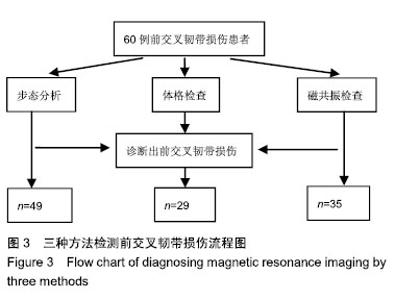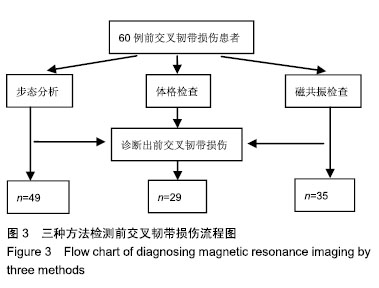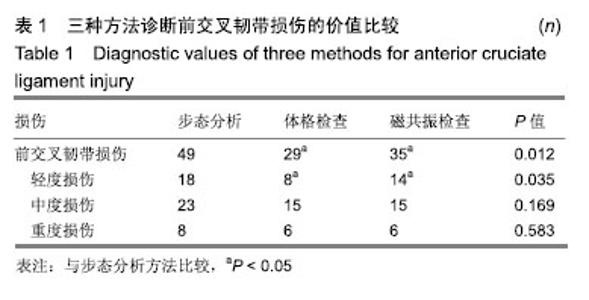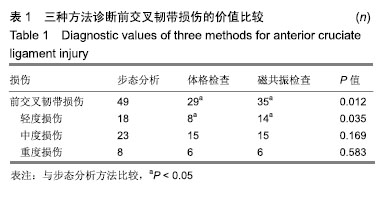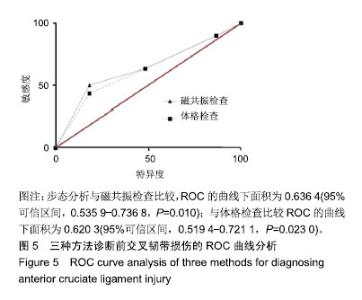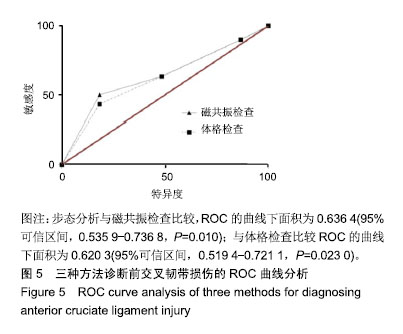| [1]Levy BA.Is Early Reconstruction Necessary for All Anterior Cruciate Ligament Tears?.N Engl J Med. 2010;363(4): 386-388.[2]Siegel L,Vandenakkeralbanese C, Siegel D.Anterior cruciate ligament injuries: anatomy, physiology, biomechanics, and management.Clin J Sport Med. 2012;22(4):349-355.[3]Fuentes A,Hagemeister N,Ranger P,et al.Gait adaptation in chronic anterior cruciate ligament-deficient patients: Pivot-shift avoidance gait.Clin Biomech (Bristol, Avon). 2011;26(2):181-187.[4]Mulligan EP,Harwell JL,Robertson WJ.Reliability and Diagnostic Accuracy of the Lachman Test Performed in a Prone Position.J Orthop Sports Phys Ther. 2011;41(10): 749-757.[5]韦启航,陆文莲,傅祖芸,等.人体步态分析系统综述[J].中国科学院研究生院学报,1991,8(2):94-106.[6]Schmitz A, Ye M,Shapiro R, et al. Accuracy and repeatability of joint angles measured using a single camera markerless motion capture system.J Biomech. 2014;47(2):587-591. [7]Velde VD,Samuel K.Evaluation of Kinematics of Anterior Cruciate Ligament-Deficient Knees with Use of Advanced Imaging Techniques,Three-Dimensional Modeling Techniques, and Robotics.J Bone Joint Surg Am. 2009;91 Suppl 1: 108-114.[8]Toutoungi DE,Lu TW,Leardini A,et al.Cruciate ligament forces in the human knee during rehabilitation exercises.Clin Biomech (Bristol, Avon). 2000;15(3):176-187.[9]Zhu Z , Li G . An automatic 2D–3D image matching method for reproducing spatial knee joint positions using single or dual fluoroscopic images.Comput Methods Biomech Biomed Engin. 2012;15(11):1245-1256.[10]Jonsson H, Kärrholm J, Elmqvist LG. Laxity after cruciate ligament injury in 94 knees: The KT-1000 arthrometer versus roentgen stereophotogrammetry.Acta Orthopaedica.1993; 64(5):567-570.[11]Logan M.Tibiofemoral Kinematics of the Anterior Cruciate Ligament (ACL)-Deficient Weightbearing, Living Knee Employing Vertical Access Open \"Interventional\" Multiple Resonance Imaging.Am J Sports Med. 2004;32(3):720-726.[12]Okazaki K,Tashiro Y, Izawa T, et al. Rotatory laxity evaluation of the knee using modified Slocum’s test in open magnetic resonance imaging.Knee Surg Sports Traumatol Arthrosc. 2012;20(4):679-685.[13]Peeler J, Leiter J, Macdonald P.Accuracy and Reliability of Anterior Cruciate Ligament Clinical Examination in a Multidisciplinary Sports Medicine Setting.Clin J Sport Med. 2010;20(2):80-85.[14]Maeyama A, Hoshino Y, Debandi A,et al.Evaluation of rotational instability in the anterior cruciate ligament deficient knee using triaxial accelerometer: a biomechanical model in porcine knees.Knee Surg Sports Traumatol Arthrosc. 2011; 19(8):1233-1238.[15]Erhart-Hledik JC, Chu CR, Asay JL, et al.Longitudinal changes in knee gait mechanics between 2 and 8 years after anterior cruciate ligament reconstruction.J Orthop Res. 2018; 36(5):1478-1486. [16]Moya-Angeler J, Vaquero J, Forriol F. Evaluation of lower limb kinetics during gait, sprint and hop tests before and after anterior cruciate ligament reconstruction.J Orthop Traumatol. 2017;18(2):177-184. [17]Fukuda Y,Woo LY,Loh JC, et al.A quantitative analysis of valgus torque on the ACL: a human cadaveric study.J Orthop Res. 2003;21(6):1107-1112.[18]Song Y, Debski RE, Musahl V, et al.A three-dimensional finite element model of the human anterior cruciate ligament: a computational analysis with experimental validation.J Biomech.2004;37(3):383-390.[19]Homyk A, Orsi A, Wibby S, et al.Failure locus of the anterior cruciate ligament: 3D finite element analysis.Comput Methods Biomech Biomed Engin. 2012;15(8):865-874.[20]Lai YC,Lin HS,Pan HF,et al.Impact of foot progression angle on the distribution of plantar pressure in normal children.Clin Biomech (Bristol, Avon). 2014;29(2):196-200. [21]Ahn JH, Jeong SH, Kang HW. Risk Factors of False-Negative Magnetic Resonance Imaging Diagnosis for Meniscal Tear Associated With Anterior Cruciate Ligament Tear. Arthroscopy. 2016;32(6): 1147-1154.[22]黄红拾,于媛媛,郭秦炜,等.前交叉韧带断裂患者步行时足底压力时间特征[J].中国运动医学杂志,2015, 34(3): 271−274.[23]Huang GB,Zhou H,Ding X,et al.Extreme learning machine for regression and multiclass classification. IEEE Trans Syst Man Cybern B Cybern. 2012;42(2):513-529.[24]Chiu MC,Wu HC, Chang LY, et al.Center of pressure progression characteristics under the plantar region for elderly adults.Gait & Posture.2013;37(3):408-412. |
